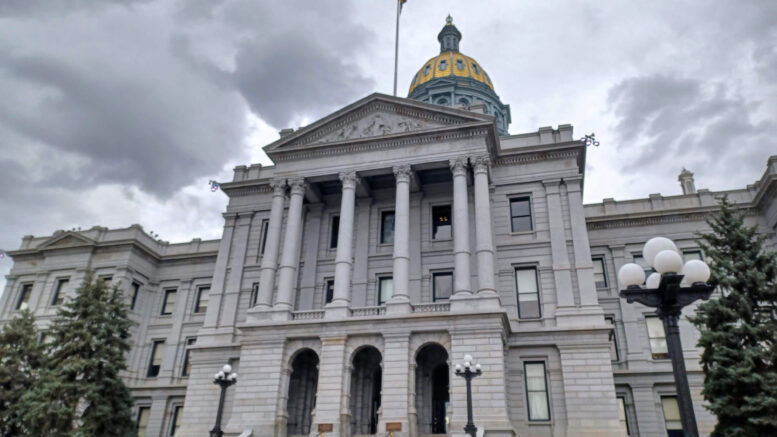Colorado stands poised to set up regulatory frameworks for alternative energy sources that, if developed correctly, could net the state “billions of dollars of wages and thousands and thousands of great jobs” in emerging fields, according to a key backer of the efforts.
But as four bills move through the closing days of the 2023 legislative session, concern is growing among some energy-industry supporters that the measures are being laden with so many environmental guardrails that they’ll dissuade any investment in the new technologies. And with the federal government offering billions in tax breaks for investment in areas such as carbon capture and clean hydrogen through the Inflation Reduction Act, any setbacks for the sectors in Colorado could leave it far behind other states offering more friendly incentives.
Colorado’s effort to nab investment and push into these new areas comes straight from Gov. Jared Polis, who issued a directive to the Colorado Oil and Gas Conservation Commission in 2022 to explore carbon capture, sequestration and utilization. In April, the Democratic governor applied to the U.S. Department of Energy, with three neighboring states, for a $1.25 billion grant to build a clean hydrogen hub that could generate 26,000 jobs while cutting emissions from sectors that are carbon-intense and considered harder to clean.
COGCC Chairman Jeff Robbins told the Colorado Chamber of Commerce’s Energy and Environment Council in February that regulating carbon capture, geothermal energy and underground natural storage could affirm the state’s place as a national leader in energy. State Sen. Chris Hansen, a Denver Democrat sponsoring three bills to set up framework for oversight of such sectors, went further in predicting a multi-billion-dollar economic impact while also developing energies that must be added to the current wind-and-solar mix if the state hopes to reach its decarbonization goals by 2050.
Four key bills
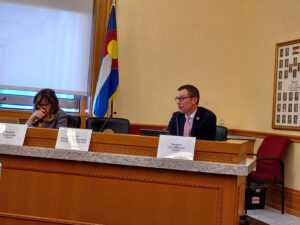
Colorado state Sen. Chris Hansen explains House Bill 1210, a carbon-management bill, to the Senate Transportation and Energy Committee.
Hansen’s Senate Bill 16 is a wide-ranging decarbonization bill, but a key provision requires the state to apply to take over permitting of Class VI injection wells — those pumped full of carbon that can be taken from the air and stored underground — from the federal government. Achieving this primacy, which Robbins estimated could happen as soon as 2025, would streamline allowing companies to use such wells in the state and make it a more attractive investment proposition.
His SB 285 would rename the COGCC as the Colorado Energy and Carbon Management Commission and would broaden its authority to include regulation of deep geothermal resources and intrastate underground natural gas storage. Leveraging the COGCC’s expertise in subsurface energy could create certainty and stability and signal that companies in this area could have comfort investing in Colorado, co-sponsoring Rep. Karen McCormick said.
House Bill 1210, which Hansen is sponsoring in his chamber, would launch the creation of a carbon-management roadmap to determine the economic and environmental potential of carbon storage, capture and utilization, and it would make many carbon-management projects eligible for grants. That bill, like SB 16, has passed both the House and the Senate and is one step away from being sent to Polis for his signature.
A fourth bill, on which Hansen isn’t involved, would direct the Public Utilities Commission to establish a review and approval process for projects involving clean hydrogen, another energy source that is key to decarbonizing areas like buildings and industrial facilities. HB 1281 also creates a state income tax credit that could be combined with new federal tax credits to spur investment in this developing area.
“We’ve got some great options. But we’ve got to use this short window of time,” Hansen said in an interview, citing the time-limited availability of lucrative federal tax credits.
Legislation has undergone significant amendments

John Jacus is a partner at Davis Graham & Stubbs.
But all the bills have been changed or padded with safeguards so significant that observers feel they make development of new energy sources, particularly carbon capture-and-sequestration and clean hydrogen, so infeasible as to be unattractive to develop. And that, said individuals like Davis Graham & Stubbs partner and energy expert John Jacus, could cause Colorado to miss out on this critical window.
Carbon capture is a growing technology where instruments can pull in carbon, usually from the primary emissions sources at factories, and pump it into oil wells in a way that boosts recovery of fuels locked underground and then stores the carbon in underground pores. Not only does it take carbon out of the atmosphere, but the process of enhanced oil recovery produces less carbon-intensive oil and gas, which in turn emits fewer greenhouse gas emissions.
HB 1210 specifically bars any grant money from going to enhanced oil recovery. And McCormick, D-Longmont, told the House Energy and Environment Committee on April 27 that sponsors removed carbon capture from the purview of the new CECMC that was outlined in SB 285 in order to get environmental groups to go neutral on the bill.
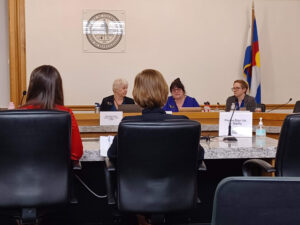
Colorado state Rep. Jenny Willford (blue dress) questions Senate Bill 285 sponsors Reps. Ruby Dickson and Karen McCormick during a hearing in the House Transportation and Energy Committee.
Meanwhile, House sponsors added nine amendments the section of SB 16 authorizing the state to seek primacy on Class VI injection wells in order to deal with concerns from environmentalists, McCormick said.
Those amendments included provisions requiring the COGCC to study the likelihood and severity of leakage incidents from Class VI wells and directing the commission to deny well-permit applications if the wells have a negative net cumulative impact on disproportionately impacted communities. Another amendment would permit local governments to impose fees on well operators for uses including the purchase of electric emergency response vehicles to deal with well leaks, even though McCormick called significant incidents “extremely unlikely.”
Effect on carbon-capture investment
Jacus said that the requirements stack up so much that many prospective carbon-capture companies will choose to invest instead in states like North Dakota, Texas or Wyoming that have streamlined regulations without so many burdens. And the safeguards are unnecessary, as carbon-sequestration has been practiced for 50 years on a smaller basis without major accidents, he said.
“This is tilting at windmills,” Jacus said. “I’m not aware of any true risk analysis of anything approaching fires that are going to break of out of a CO2 injection.”
But Valley Lopez, promoting climate solutions coordinator for climate-defense group 350 Colorado, said carbon-dioxide pipelines are direct health risks and carbon sequestration is an earthquake risk. He told the Senate Transportation and Energy Committee during its HB 1210 hearing Monday that reforestation has far greater potential for cleaning the atmosphere than carbon capture-and-sequestration, and he urged members to “remain wary” of the practice.
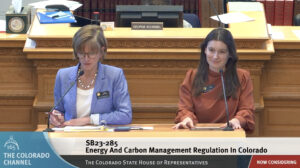
Colorado state Reps. Karen McCormick and Ruby Dickson present Senate Bill 285 to the House.
In general, opponents of carbon-capture project approvals or funding say they don’t want to put state resources toward programs that continue to extract oil and gas. Several groups, noting that the vast majority of carbon-capture technologies are used for enhanced oil recovery, said they didn’t even like the idea of changing COGCC’s name because it opens the door to allowing more carbon sequestration.
“We seem to be chasing the federal funding and then looking around for a project to match that,” Jan Rose from the Colorado Coalition for a Livable Climate told the House Energy and Environment Committee in March about HB 1210. “Our position at the CCLC is that the best way to manage carbon is not to burn it in the first place.”
Why new energy sources are important
If Colorado makes it too difficult to do carbon capture, companies will undertake projects in other states and then ship oil and gas into Colorado, generating more emissions along the way than would come from injection wells, Jacus said. And there will be few efforts to capture carbon from the atmosphere, as such technology needs the return on investment that use in enhanced oil recovery can produce.
“We can reduce our carbon footprint much quicker if we can take CO2 from sources like gas plants and pump it into the ground,” he said. “That is the best solution going forward. But it seems to me they are ideologically opposed to using some of that legacy oil and gas infrastructure ever for sequestration resources.”
Hansen acknowledged the safeguards added in the House to SB 16 seemed a bit much, comparing them to “putting a belt on top of suspenders on top of a belt,” especially because he doesn’t envision Class VI injection wells going into disproportionately impacted communities. But he also said that he doesn’t anticipate they will have a significant impact on development of carbon sequestration, which he sees taking carbon from facilities like breweries and using it in existing wells further from homes.
New energy needs to be clean
Meanwhile, hydrogen advocates are worried that a similar overly burdensome safeguard on HB 1281 could halt investment in that industry just as the state seeks to rev it up through a potential clean-hydrogen-hub designation.
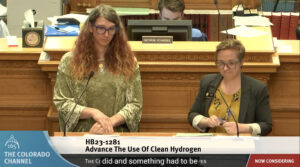
Colorado state Reps. Brianna Titone and Stephanie Vigil explain their bill on clean Hydrogen to the House.
An amendment added by sponsoring Democratic Reps. Brianna Titone of Arvada and Stephanie Vigil of Colorado Springs requires that any hydrogen that qualifies for state grants be produced through a method known as “hourly matching.” That means that it could be made only during hours when the electrolyzers turning water into hydrogen energy are using solar or wind power, which will ensure the fuel source does not increase greenhouse gas emissions.
Vigil and Titone defended the language during an April 27 discussion in the House Finance Committee, saying that even if it will raise some costs in the immediate future for hydrogen producers, it’s important to ensure the energy is truly clean. Rep. Mike Weissman, D-Aurora, later said that while clean hydrogen may be a necessity to decarbonization, the state must pay close attention to the energy used to produce it.
“This is a very powerful new technology. If done correctly, it gives us the power to decarbonize industries that can’t do it using wind and solar alone,” Vigil said. “But it also gives us the ability to subsidize burning fossil fuel.”
Obstacle to clean hydrogen development?
In an April 27 letter to HB 1281 sponsors, a coalition of seven clean-energy companies and organizations cited several studies showing the hourly-matching requirement could boost costs as much as 175% and disincentive green-hydrogen investments. They asked Titone and Vigil to hold off putting such a standard into law, especially while the federal government is scheduled by August to release its own definition of “clean hydrogen” for grant purposes and the state could prove to be out of alignment with that.
No other state has included hourly matching in its clean-hydrogen regulations, leaving Colorado as a potential outlier whose rules could negate the benefit of federal tax credits and incentivize production of blue hydrogen, which uses natural gas as the electrolyzer’s fuel source, said Riley Smith, senior manager for strategy and production solutions for Next Era Energy Resources. Electrolyzers are costly pieces of equipment, and if their use is limited to hours when the sign is shining or the wind is blowing, that could reduce their efficiency greatly and could double the cost of hydrogen production because they would have to build storage for the hydrogen to ensure a constant flow to customers, he said.
“It increases the price to such an extent that it’s no longer cost-competitive with blue hydrogen or gray hydrogen,” Smith added, suggesting such environmental safeguards could end up being detrimental for emissions.
There remain several opportunities for further debate on the bills. HB 1281 is set for a hearing in the Senate Finance Committee today, SB 285 still must get final approval in the House and Hansen must decide whether to concur with the host of House amendments on SB 16 or go to conference committee to work out differences with them.
